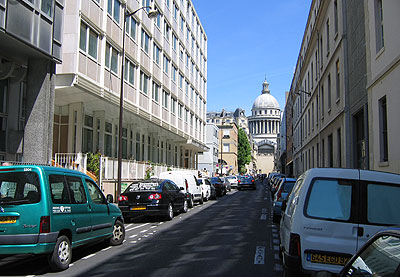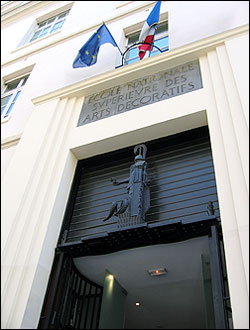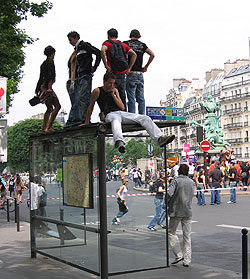UC Berkeley Web Feature
 |
The
Arts-déco is at No. 31 Rue d'Ulm, in the center
of the Latin Quarter and in view of the Pantheon.
This was an ideal location in '68, and many
students and other activists passed through
the workshop to request posters for
strikes and to help with production. (Photos by Gene Tempest except where noted) |
The beginning of research and the end of the World Cup
 The main entrance to the ENSAD, known as the Arts-déco, an art school that was the center of poster production in 1968. French and European Union flags have since replaced the red Communist flag and black Anarchist flag that adorned the façade. |
PARIS - June 24, 2006, was the journée portes ouvertes ("open door day") at the Ecole Nationale Supérieure des Arts-Décoratifs (ENSAD), or Arts-déco, one of Paris's premiere art schools. Award-winning masters' projects were on display, and the public was invited. Photographs were tacked to the walls of vast showrooms with high ceilings, while films, sculptures, and textiles were hidden in dark little closets between floors and in the basement — everywhere. The school had been taken over by student work.
On May 13, 1968, students and alumni had also occupied the Arts-déco, turning it into an atelier populaire ("people's workshop"). There they printed hundreds of thousands of posters for the striking students and workers of mai ‘68. (For a description of the movement, see box below.)The Arts-déco of "open door day 2006" showed no trace of this revolutionary past. The building — the architecture, even — has forgotten itself.
In 1968, the poster workshop had been set up on the university's top floor. The atelier was poor but the atmosphere was rich, heavy with smoke from students' ever-burning cigarettes.
| Background on Mai '68 Mai '68 can perhaps best be understood
as a product of its times. Students who participated
in the revolution came of age politically
during France's wars in Indochina and Algeria
and also the U.S. war in Vietnam. Today,
participants are known as 68ards (68ers),
a name whose whole identity is a year that
also saw the occupation of New York's Columbia
University, the Mexico City Olympics massacre,
and Eastern Europe's "Prague Spring." |
To supply the workshop, ink had been sought from sympathetic galleries, or purchased with funds collected in the streets. Paper was donated by newspapers — often by the Communist daily, L'Humanité. When a newspaper has finished printing its edition, there is a left-over roll of paper too thin to be pulled through the presses, but still fat with a hundred meters' worth of paper. L'Humanité donated these vestiges to the students' cause.
At the Arts-déco, The silkscreening frames were near the spiraling stairs, and as the revolutionaries printed, they unrolled the paper down into the stairwell to dry. By the time the prints had reached the ground floor, they were ready to be cut and taken to the walls of Paris as posters.
I could not find this almost-mythical place on my visit, and here is why: An elevator had been built in the '80s or '90s that filled the entire stairwell.
I tried to decide if the stairwell was a relic worth preserving. Today, posters from 1968 are prized by collectors. But would a museum have bid on the space between the spiraling stairs?
The question of "what to do" with history seems ever-central in Paris, where you cannot erect a new building without tearing down centuries' worth of history.
What should one do with history, then?
A perfect circle of information
The BDIC, the Bibliothèque de Documentation Internationale Contemporaine (the awkwardly translated "library for contemporary international documentation") at Nanterre, just outside of Paris, offers one answer: preserve history, but do not lend it.
My first day at the BDIC, I had suffered — as Christlike as a girl of 20 living in Paris for the summer can be said to suffer — through an hour-and-a-half-long orientation to become an official reader.
| About Student Journal 2006 [an error occurred while processing this directive] |
The librarian, who had also taken on a biblical, prophet-like glow in the late morning light, always began and ended his advice in the same place, and I wondered if in this perfect circle of information I had learned anything at all.
"Ask for permission to take photographs of a book," he would logically note, but only then to amend, fatally: "Unless you decide that you want to photocopy it, which you could do without permission — with certain books — but if you're not allowed to photocopy you can always use a scanner (which is more expensive) — or you can photograph (without a flash) as long as you have asked first (and filed the appropriate paperwork)."
He was a king of parenthetical expressions, run-on-sentences, and grammatical labyrinths. "The BDIC is not for researchers, but for the research material itself. The library's main purpose," he concluded with enraptured emphasis, "is to CONSERVE things."
He handed me my reader's card, No. 1100033805, and I asked if I could check out books.
"NO, this library certainly does NOT lend any books," he said, standing up. "Perhaps, mademoiselle" — he armed this last word with threatening courtesy — "you would be more comfortable at the university library on the other side of the building."
Les bleus and the gold
Walking from "open door day" at the Arts-déco to the metro, I thought about the BDIC's almost compulsive approach to history. Their history was a file, cross-listed and stamped with a call number — called a cote in French. My interviews and oral history work were another kind of history, and I remembered what my friend, a Le Monde correspondent, had said to me a week before, "It is the most wonderful job in the world — to have people tell you their stories for a living."
 For a better view - and a premiere dancing spot - young protesters climb onto bus stops during a gay rights march. |
I walked past a gay-rights march. Protesters danced behind decorated trucks to blaring techno music. The Communist and Socialist parties were present, but so was the Paris Wrestling Club and even Paris Foot Gay, a group working with PSG (Paris St. Germain), the Parisian soccer team.
Politics and football — these are often one in France. The World Cup is more than a fever, it is like a mother's obsession with her favorite, most handsome and successful child. Grown men hold hands during games, embrace after goals, whine about, plead for, and baby their team. The commentators call French goalkeeper Fabien Bartez by his first name, "Oui! Fabien, impécable!" ("yes, Fabien, impeccable!"), and beg "pas de faute, pas de faute" ("no foul, no foul") whenever a defender "undresses" an opponent near the box.
When France beat Portugal and secured a spot in the finals, people sang in the streets: "On est en finale! On est en finale! On est — on est — on est en finale!" ("We're in the finals!"). Drivers honked their horns all night, and a special rap single was released, "Zidane il va marquer, Zidane il va marquer!" ("Zidane is going to score!"). Five people died that night, most in drunken accidents.
The special "final edition" of the Journal du Dimanche reserved the first 12 pages to World Cup coverage, only getting to the latest news from Gaza on page 13. Every advertisement had a word of encouragement for les bleus, as the French team is called.
There are 11 players on the field, and there were almost as many commentators in the TF1 media box that night. The French believe that the public is the "12th man," a very important player indeed.
When les bleus lost to Italy in penalty kicks, the next day's newspapers ran cover stories with bold, black headlines: "Merci!" Forgiving the loss — as well as the French captain, Zinadine Zidane, thrown out of the game for intentionally head-butting an opponent — they welcomed their heartbroken children home.
